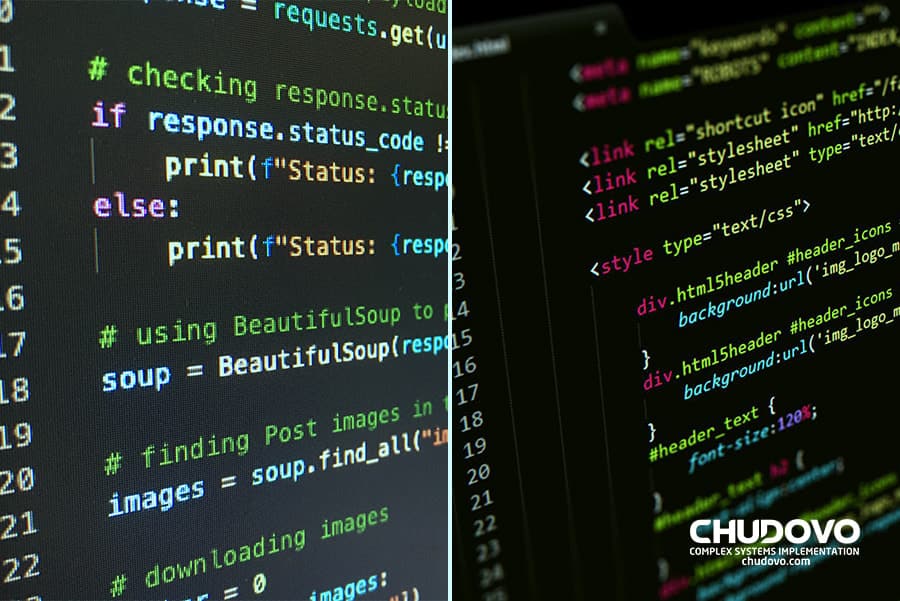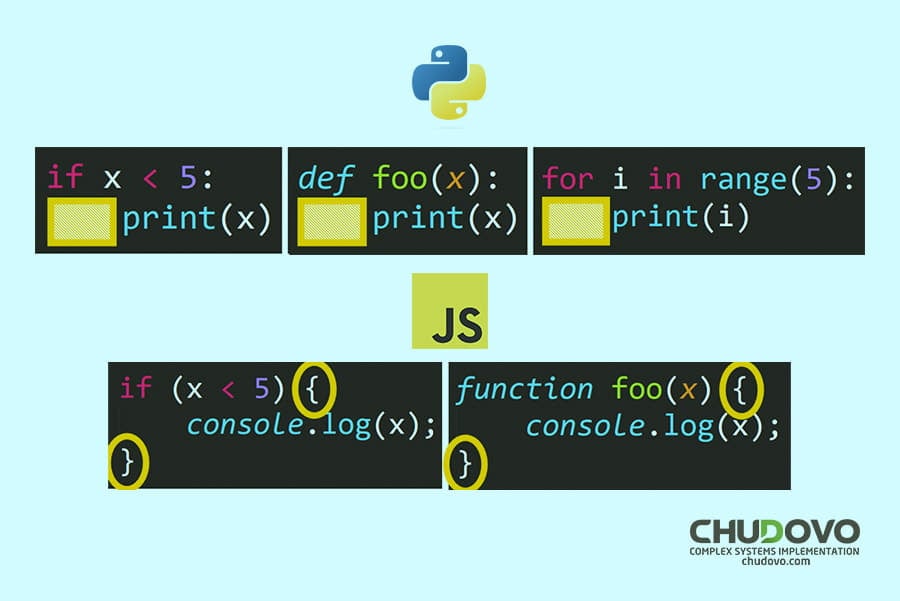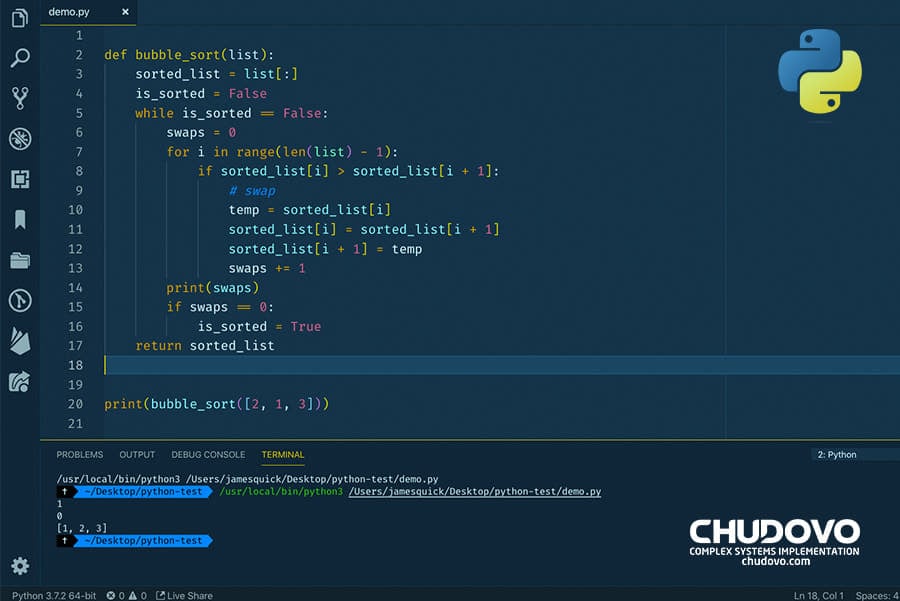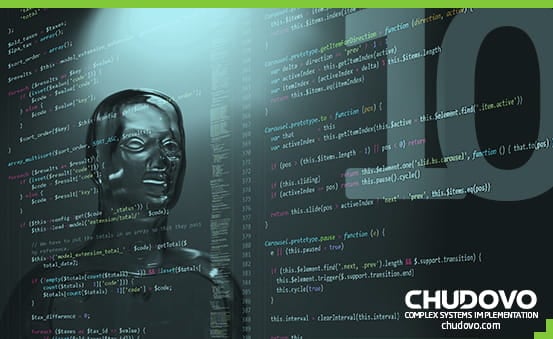Python vs. JavaScript: Full Comparison of Features and Benefits
According to articles by Forbes and Coursera, Javascript and Python are two of the most used programming languages in the world. They are both object-oriented languages, are beginner-friendly and pair well with other programming languages. And sometimes, they work great with each other.
However, situations arise for developers and development teams where they can choose between Javascript and Python for a particular software product. In that case, they’ll need a handy guide for outlining and comparing the best and worst of both programming languages before making a choice.
In this programming language guide, we define Python and Javascript and list their top features and show you what you stand to gain or lose while coding with either one. And lastly, we make a tabular Python vs. Javascript comparison for a clearer view and offer advice on choosing the language for your project.
Table of content
- Overview of Javascript Programming Language
- What is javascript?
- Features of Javascript
- Uses and Applications of Javascript
- Advantages of Javascript
- Disadvantages of Javascript
- Overview of Python Programming Language
- What is Python?
- Features of Python
- Uses and Applications of Python
- Advantages of Python
- Disadvantages of Python
- Difference between Javascript and Python
- Comparing the features and benefits of Python and JavaScript (Table)
- When to use Javascript and when to use Python?
- Conclusion
- Frequently Asked Questions (FAQs)

Overview of Javascript Programming Language
Let’s dig into the definition, features, advantages, and applications of Javascript.
What is Javascript?
Javascript is a lightweight software programming scripting language that programmers use to design and create dynamic web pages, as opposed to static pages. It’s a scripting language used to create exciting and interactive experiences for users with elements such as dynamic background colors, animated graphics, dropdown menus, etc.
Generally, developers use Javascript as another layer alongside CSS and HTML to create their dynamic web content. CSS cannot maintain user interaction or attention; hence, the use of Javascript to make the page come alive.
If you’re visiting a website and elements on the page are animated, or it shows 3D/2D graphics animation or interactive maps, then there’s a high possibility that Javascript is behind it.
Features of Javascript
Javascript has various features that make it unique. Here are a few features of javascript:
- Prototype-based instead of class inheritance
- Users can submit valid data to the client side during submission through client-side validations
- Functional programming support
- Objects that can inherit properties of others
- Presence of control statements like loop and switch case
- Functions, keywords, variables, and names are case sensitive
- Javascript is lightweight
- Javascript has event-handling
- Javascript executes the script on the client side in the browser
- Object shorthand allows developers to save space and time
- Users can add dynamic HTML content
Uses and Applications of Javascript
The most popular use or application of Javascript in software development is for building web applications. However, there are other uses Javascript has come to be known for. Below are other applications of Javascript currently:
- Web applications
- Web development
- Game development
- Web servers
- Server applications and others
Web applications
Javascript and Javascript frameworks are used in web application development to improve user interaction with web pages. A good example would be the Google Maps application, where Javascript powers dynamic functions without server communication. To zoom into the map or move the map to view another area, users can simply click on the map and drag it to their desired view.
Web development
Javascript has been critical to the look, feel, and success of famous websites, including Facebook, Google, eBay, Amazon, and many more. Developers use Javascript to execute complex actions, load content within a page without reloading the entire site, support external content like widgets and PDFs, and create an interactive and dynamic user experience.
Game development
Game development is another crucial application of the javascript programming language. Javascript and HTML5 combine to provide web access and rich animated graphics without additional plugins.
Web servers
Javascript empowers developers to save time creating web servers by using Node.js to develop back-end infrastructure and web servers.
Server applications
Also, using Node.js, Javascript helps developers create scalable and fast applications by enabling the writing, testing, and debugging of code. They do this by writing server-side code in the open-source runtime environment of Node.js.
Mobile applications
There are more people using mobile applications on their mobile phones nowadays, increasing the need for faster development of scalable and fast mobile apps. Javascript keys here through javascript frameworks that enable the development of mobile apps for devices such as Android, iOS, and Windows. Some frameworks even work across platforms, allowing developers to build one app that works on more than one type of device.
Other applications of javascript include the following:
- A combination of Javascript and HTML5 enables 3D and 2D drawing on web pages
- Node.js allows you to control an airborne robot using Javascript
- Javascript can be used to create apps for smartwatches. An example would be Pebble.js for Pebble smartwatches
- Various javascript libraries can help you create interactive and dynamic presentations as a web page

Advantages of Javascript
Javascript has numerous features that make it a preferred choice over other programming languages. Some advantages that javascript has over its counterparts include the following:
- Update to the guidelines: ECMA International and the creators of Javascript regularly update Javascript according to recent advancements and developments by publishing updates and creating new libraries and frameworks. By doing this, they ensure that Javascript maintains its relevance within software development circles.
- Community support: Javascript has a substantial online community filled with developers who share knowledge and insight about javascript-related topics. From these forums and resources, beginners aren’t left to themselves as they can consult these resources and have clear access to more experienced developers to learn and grow their knowledge and technical skills in Java development.
- A versatile language: Aside from making web content come alive and increasing user interaction, Javascript makes machine learning and data science accessible to developers who understand the language. Also, it’s compatible with languages like Java, Perl, and PHP.
- Fast load times: Some other languages would need to connect to a server or computer first before executing their scripts. But with Javascript, that doesn’t need to happen as the scripts are executed in the browser directly. Javascript also runs faster than some other languages.
- Simple and lightweight: Many developers find Javascript easier to work with because of its more straightforward structure. Beginners won’t find it challenging to learn and implement the language when needed. In this case, developers can easily spot and rectify errors.
- Server load: Since the user operates with Javascript on the client side, server requests are reduced, only requested sections are updated instead of the whole page, and data is validated with the web browser.
Disadvantages of Javascript
Javascript is a worthy language to choose when building a dynamic web page. But it does come with a few commas of its own, and they include the following:
- Debugging with javascript is a chore: Debugging your code on html editors becomes more complex as the editor doesn’t provide as much support as others. There aren’t any notifications about code errors, so it’ll be more challenging to find where the problem is coming from.
- Not as secure as others: Although javascript is famous for other things, it’s not so popular for its security. Irresponsible users can take advantage of client-side code as it’s vulnerable to attacks from that end.
- Issues with compatibility with several browsers; there are multiple browsers currently in use, including the popular and less popular ones. Each of these browsers displays javascript code differently than the rest. Hence, before moving on to the next stage, the developer needs to test their javascript across the most popular browsers their target audience will likely use.

Overview of Python Programming Language
Let’s dig into the definition, features, advantages, and applications of Python.
What is Python?
Python is a high-level object-oriented programming language created by Guido van Rossum and used in creating a myriad of computer programs. It’s one of the most widely-used, beginner-friendly programming languages out there and is extremely popular among developers of all expertise.
Aside from using it to build websites and software, developers can also use Python to run data analysis and automate certain tasks. It has no specific specialty and has a wide range of uses. This multifacetedness is why other professions, such as accounting and the sciences, apply Python to their tasks.
Features of Python
Python is one of the most used programming languages and for good reason. The following are features of Python that make it attractive to developers:
- A simple, human-like syntax that makes it easier to read
- It can be used to create Graphical User Interface (GUI)
- Extensible and embeddable in other languages
- Open-source and free to download and use
- Supports object-oriented programming, functional programming, and structured programming
- High-level language that’s easy to understand compared to middle-level languages like C
- Large code library that includes modules and packages
- It can run cross-platform, removing the need to write separate code for each platform
- Popular with an extensive community support
Uses and applications of Python
Python can be used in various professions and has been known to carry out varying tasks. Below are some uses and applications of Python:
- Backend web development
- Everyday tasks
- Software prototyping and testing
- Scripting or automation
- Machine learning and data analysis
Backend web development
In web development, Python is used to develop an application or website’s backend. Python ensures the product’s security, routes URLs, communicates with databases and processes data. It also sends data to and fro servers.
Everyday tasks
The usefulness of Python as a programming language goes beyond building websites and software applications. In some professions, python is used to make jobs easier, quicken the completion of tasks, assist with data processing, and many more things.
Some of the everyday tasks Python can automate are converting text to a spreadsheet and vice-versa, renaming large batches of computer files, stay on top of crypto and stock prices. It could even help you assign tasks to family members at random.
Software prototyping and testing
Just like how Python can automate everyday tasks, developers can also use the programming language to automate software testing to test new features in an app or to test a product they’re building. Also, python is used for tracking bugs and build control.
Scripting and automation
In software development, Python is often used to automate mundane development tasks. The developer writes the script (the scripting process) for running such a task using the Python language, and the task becomes automatic once all criteria have been met.
Machine learning and data analysis
Python has become a staple in the data analysis and machine learning world. With Python, data scientists can analyze and manipulate data, carry out complicated statistical calculations, and visualize data with 3D plots, histograms, bar charts, graphs, etc.

Advantages of Python
Python has some advantages over other languages and within itself, including
- Beginner-friendly: Python is a beginner-friendly language mainly because of its syntax. It’s written in everyday language, making learning easier for students. That’s why schools like to start with Python when teaching a programming class to their students.
- Code less, achieve more: With Python, there’s no need to spend time trying to understand how the language behaves. It’s pretty simple to read, write, and understand, allowing you to write less code to increase productivity and achieve more than other languages.
- Interpreted language: Python carries out a line-by-line execution of code. Whenever there’s an error, it stops executing and flags that error, making debugging easier since the developer can stop, resolve problems one at a time, and move on.
- Free to use: Anyone can download, use, modify, and republish their version of Python without repercussion. It’s open-source, meaning it’s free to download the source code and use it for your projects.
- Extensive library: Python has a large standard library where you can find any function you need to build. And it keeps growing, thanks to its developer community that continually updates the community with new insight.
- Cross-platform compatibility or portability: Python’s portability allows you to write and run one Python code for other platforms. Whereas with other languages, you’ll need to write a different code for it to work.
Disadvantages of Python
From the features, definition, use cases, and benefits, it’s easy to want to choose Python over others. But you should know about the disadvantages of Python before committing. The following are the disadvantages of Python programming language:
- Runtime error: Python interprets the code dynamically. Hence, runtime errors can occur in the future in instances where a variable contains integers holding a string. A solution can be to thoroughly test the program for these errors.
- Problems with database access: Interacting with the Python database can be problematic. Its access layer still stands grossly underdeveloped and primitive, especially compared to other technologies.
- Mobile computing is weak: Python’s slow processing power and lack of memory efficiency make it a poor candidate for building mobile applications or developing the client side of applications. That’s why it’s mainly used for backend, server-side programming.
- High memory usage: Using Python is simple and treats everything as an object, but this causes many objects to be active during execution, leading to massive memory consumption. This lack of memory efficiency makes it a poor choice for applications or software requiring low memory usage.
- Not suitable for speed: Due to Python’s dynamically-typed and interpreted nature, developers will experience slow execution of code because Python does a line-by-line execution. Even though this might be great for clean and thorough debugging, it slows down the process and is hence, not a good fit for projects requiring faster speed.

Difference between Javascript and Python
Javascript and Python are interesting languages with a place where they fit. But they have their differences.
- Python is a dynamic programming language with vast use cases spanning data analysis, machine learning, and web development. However, Javascript is only used for building native applications and websites.
- Getter and setter functions are what define attributes in Python. But in Javascript, the properties of objects are sourced from already-existing, underlying attributes
- Python uses indentation, and Javascript uses curly brackets
- If you do not specify an encoding format, Python’s source code is in ASCII, but Javascript doesn’t have support for the manipulation of raw data and hence must be encoded as UTF-16
- Python is a high-level object-oriented programming language with features that support rapid development. But javascript is a scripting language used for creating dynamic web pages.
- Python has concepts of immutable and mutable data types, but Javascript doesn’t.
Comparing the features and benefits of Python and JavaScript (Table)
Now that you know the definitions, features, differences, and advantages, we’ll compare the features and capabilities of Python and Javascript using the table below.
| Factor | Python | Javascript |
| Speed | Slower, due to dynamically-typed and interpreted code | Faster speed |
| Ease of learning | Syntax is English-like and is easier to understand | Not as easy as Python |
| Encoding format | Uses ASCII as default | UTF-16 |
| Implicit conversions | Unsupported but allows strong and dynamic typing | Supports implicit data type conversion; hence, weakly types |
| Mobile and web development | Python web apps take a longer time to respond | JS web apps are faster |
| Client-side vs. server-side | Best for server-side | Best for client-side |
When to use Javascript and when to use Python?
No one answer fits all scenarios, but the basic idea would be to consider what type of project you’re building or task you want to complete and choose based on that. Keep in mind that it’s possible that neither Javascript nor Python may be the best programming language to use, and you might have to search elsewhere.
When making your choice, ask yourself these questions:
- Backend or frontend?: Javascript is more suited for frontend, client-side development, while Python is best for backend development.
- Are you undertaking essential web development?: If you’re building a project only concerned with developing a basic, dynamic website or webpage, then you might be better off with a combination of Javascript, CSS, and HTML. Layering these three would give you smoother results.

Certified engineers
Convenient rates
Fast start
Profitable conditions
Agreement with
EU company
English and German
speaking engineers
- Is your goal advanced automation, analysis, or machine learning?: Developers or non-developers who want to get into using a programming language for machine learning, to run advanced data analysis on statistical data, or to automate office and everyday tasks should use Python. Javascript does not have the features or capabilities for smoothly running any of these tasks.
- Are you an aspiring developer or a non-developer who wants to learn a versatile programming language?: Aspiring developers and non-developers who want to add to their skillset may want to learn a language that’s simpler, easily understandable, and versatile. Compared to Javascript, Python is the best option. It’s written in English-like language, and it has applications that transcend web development.

Conclusion
Generally, the comparison and notes above show Python’s simple nature with the language, but where it rises in simplicity, it falls in speed. And speed is where Javascript shines through.
However, all that wouldn’t matter because you’ll need a project-specific language, whether you’re visualizing data, processing information, or building the interactive front end of a website. Neither outshines the other totally, but if you combine their strengths and weaknesses, you can have something beautiful, dynamic, fast, and scalable.
If you’re not a developer and would like more advice on choosing between Python and Javascript, contact an established or mid-level developer for expert tips. Or read more articles like this one and gain some much-needed insight.
Frequently Asked Questions (FAQs)
Is Javascript better than Python?
The answer would depend on what you want to use the languages for. If you’re looking at automation, Python is better. But if you’re looking at front end development, Javascript is the better option.
What are the similarities between Python and Javascript?
- Both do not rely on class definitions
- They’re beginner-friendly
- Python and Javascript are object-oriented
What is the main difference between Python and Javascript?
Python’s code is simple and easy to read, while Javascript’s code is hard to read and maintain. Also, Python is a server-side language, while Javascript is client-sid
If you are thinking of starting a new Python or Javascript project, contact us now!




